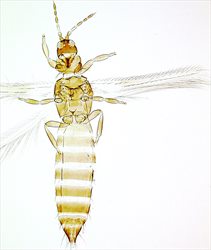
Female

Pronotum
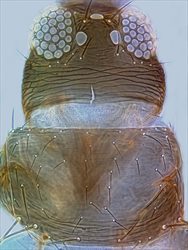
Head & pronotum

Antenna

Antenna
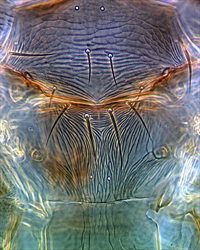
Meso & metanota

Tergite II

Tergite VIII
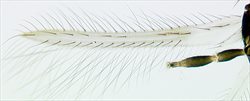
Fore wing
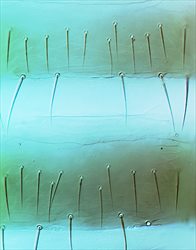
Female sternites VI-VII
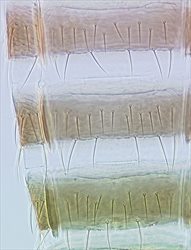
Female sternites V-VII
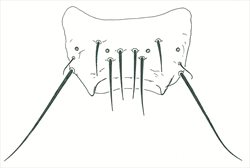
Male tergite IX
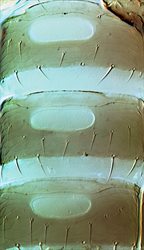
Male sternites III-V
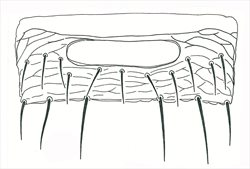
Male sternite V
Both sexes fully winged. Body and legs brown, tarsi yellowish brown, antennal segment III usually brown but sometimes yellowish; fore wings shaded in distal two-thirds. Antennae 8-segmented; segments III–IV each with forked sense cone. Head with cheeks convex, with 2 pairs of ocellar setae; pair III arising on anterior margins of, and slightly longer than side of, ocellar triangle; postocular setae pairs I & III well-developed but shorter than ocellar setae pair III, postocular setae pair II minute. Pronotum anterior margin longest setae no more than 1.5 times as long as discal setae; with 2 pairs of long posteroangular setae; posterior margin with 3 (or 4) pairs. Mesonotum with anterior campaniform sensilla, median setae arise well in front of posterior margin. Metanotum with parallel lines of sculpture converging medially at posterior; median setae arising near anterior margin; campaniform sensilla present. Fore wing first vein with 5 or more setae on distal half; second vein with complete row of about 14 setae. Abdominal tergite II with 3 lateral marginal setae, V–VIII with paired ctenidia, on VIII posteromesad to spiracles; tergite VIII posteromarginal comb complete, microtrichia long and regular; pleurotergites each with 3–4 discal setae, posterior margin not dentate; tergite IX with 2 pairs of campaniform sensilla, X with median split. Sternite II with few or no discal setae, III–VII with 8–20 discal setae in irregular double row, most numerous on posterior sternites; sternite VII setae S1 arise in front of margin.
Male similar to female but smaller; tergite VIII without posteromarginal comb; tergite IX median setae slender; sternites III–VII with broadly transverse pore plate in front of discal setae, these pore plates progressively smaller on posterior sternites.
The genus Thrips is the second largest genus in the Thysanoptera, and currently includes, worldwide, over 290 species. All members of genus Thrips lack ocellar setae I on the head, and they all have ctenidia on tergite VIII posteromesad to the spiracles. Other characters, such as number of antennal segments, number of setae on the fore wing veins, and number of discal setae on the sternites are variable between species (Palmer, 1992; Nakahara, 1994; Mound & Masumoto, 2005). Thrips atratus is particularly similar to the less common species Thrips verbasci, but the setae on the anterior margin of the pronotum are not as long. It also shares most character states with Thrips vulgatissimus, but that species has fewer setae on the first vein of the fore wing.
Feeding and breeding in the flowers of its host plants, and associated particularly with species of Caryophyllaceae and Lamiaceae.
Recorded across Britain north to the Shetland Islands, and also from Northern Ireland as well as the Republic of Ireland (Morison, 1929; Mound et al., 1976; O'Connor, 2008), this Holarctic species is widespread in both Europe and North America (Nakahara, 1994; zur Strassen, 2003).
THRIPIDAE - THRIPINAE
Thrips atratus Haliday
Thrips atratus Haliday, 1836: 447
Physothrips atrata var. adusta Uzel, 1895: 108
Ceratothrips britteni Bagnall, 1914: 2
Taeniothrips longicornis Priesner, 1926: 305
Morison GD (1929) Observations and records for some Thysanoptera from Great Britain. V. Physothrips spp.. Entomologist’s Monthly Magazine 65: 113–127.
Mound LA & Masumoto M (2005) The genus Thrips (Thysanoptera, Thripidae) in Australia, New Caledonia and New Zealand. Zootaxa 1020: 1–64.
Mound LA, Morison GD, Pitkin BR & Palmer JM (1976) Thysanoptera. Handbooks for the Identification of British Insects 1 (11): 1–79.
Nakahara S (1994) The genus Thrips Linnaeus (Thysanoptera: Thripidae) of the New World. United States Department of Agriculture. Technical Bulletin 1822: 1–183.
O’Connor JP (2008) A review of the Irish thrips (Thysanoptera). Irish Naturalists’ Journal 29: 20–24.
Palmer JM (1992) Thrips (Thysanoptera) from Pakistan to the Pacific: a review. Bulletin of the British Museum (Natural History) Entomology Series 61 (1): 1–76.
zur Strassen R (2003) Die terebranten Thysanopteren Europas und des Mittelmeer-Gebietes. Die Tierwelt Deutschlands 74: 1–271.